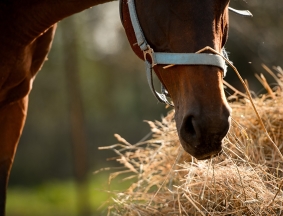A horse must be fed a balanced diet to stay healthy and perform well. An optimal hay- or haylage-based diet is often difficult to achieve; after all, forage varies from batch to batch, meaning you never really know exactly what your horse is eating. With forage analysis Equi Feed, you will have insight into the quality of the forage – and, if necessary, you can then supplement the feed with concentrate or supplements. Equi Feed allows you to give your horse the best possible diet.
Optimising feed for a horse or pony is quite a challenge. Horses have a special digestive system with a small stomach that is geared up for small bits of feed throughout the day. Most of this food is broken down after it passes the stomach, in the cecum and large intestine by intestinal bacteria, earning horses the title of hindgut fermenters. It is important to keep gut bacteria active with plenty of fibre. This fibre is found primarily in roughage such as grass, hay, and haylage. As a rule of thumb, a horse should get at least 1.5% of its body weight in dry matter from roughage daily to meet its fibre needs. This also means that forage should contain the main part of your horse’s diet.
In addition to fibre, the feed must also contain sufficient energy, minerals and trace elements for a healthy horse to develop and perform well. When feeding too much or not enough nutrition, fibre, minerals or trace elements over a longer period of time as a result of a high or low analysis result, deficiencies or excess of can occur within the equine body resulting in health problems or reduced performance. Nevertheless, research has shown that 60% of all equine health problems are related to inadequate feeding. In conclusion, a balanced nutritional value, fibre-, mineral- and trace element content will determine the health and therefore performance of the horse.
| Name | Date | File |
|---|---|---|
| Brochure Equifeed | 14-04-2023 | |
| Fact Sheet Equi Feed | 09-04-2024 | |
| Sampling protocol Equi Feed | 09-04-2024 |
Analysis
Equi Feed is analysed using the NIRS method. Near infrared spectroscopy (NIRS) for solid materials was developed in the 1960s. NIRS allows for fast, quantitative, non-destructive, and cost-effective estimation of multiple physical, biological and chemical forage characteristics from the same spectral data once sufficient large data databases have been established. Eurofins started with the NIRS system for forage in 1986.

